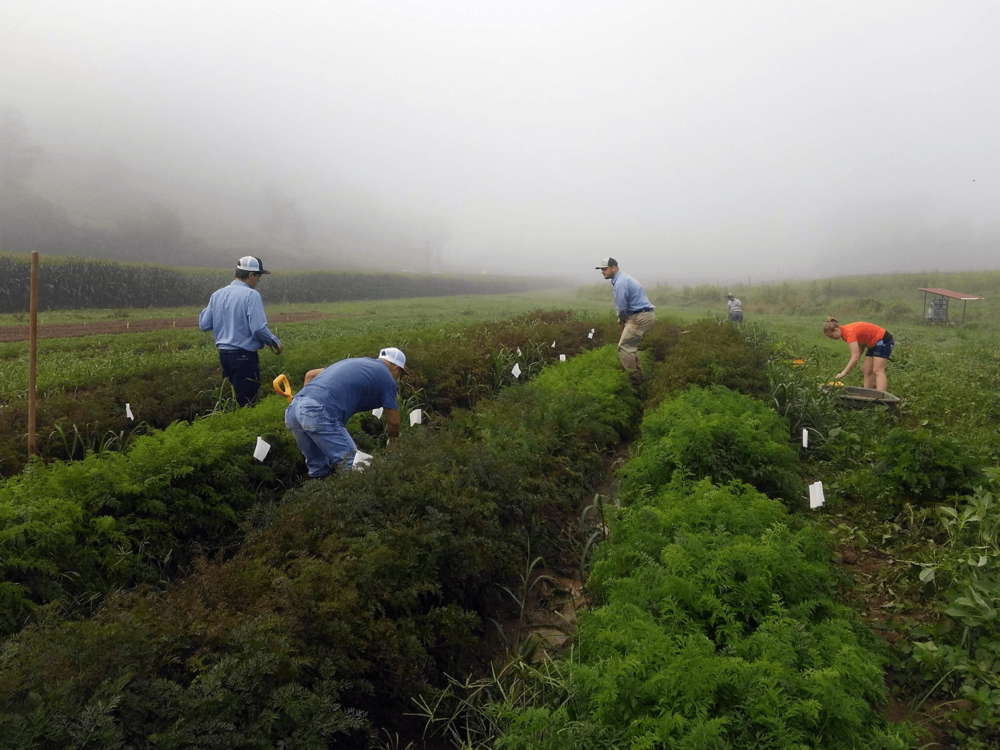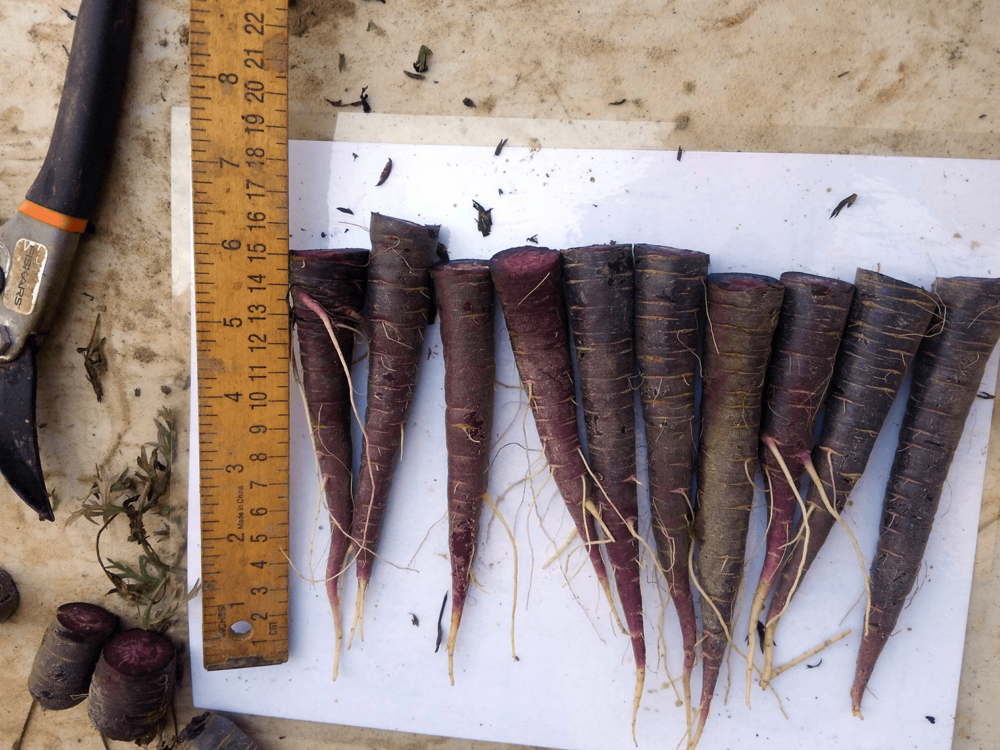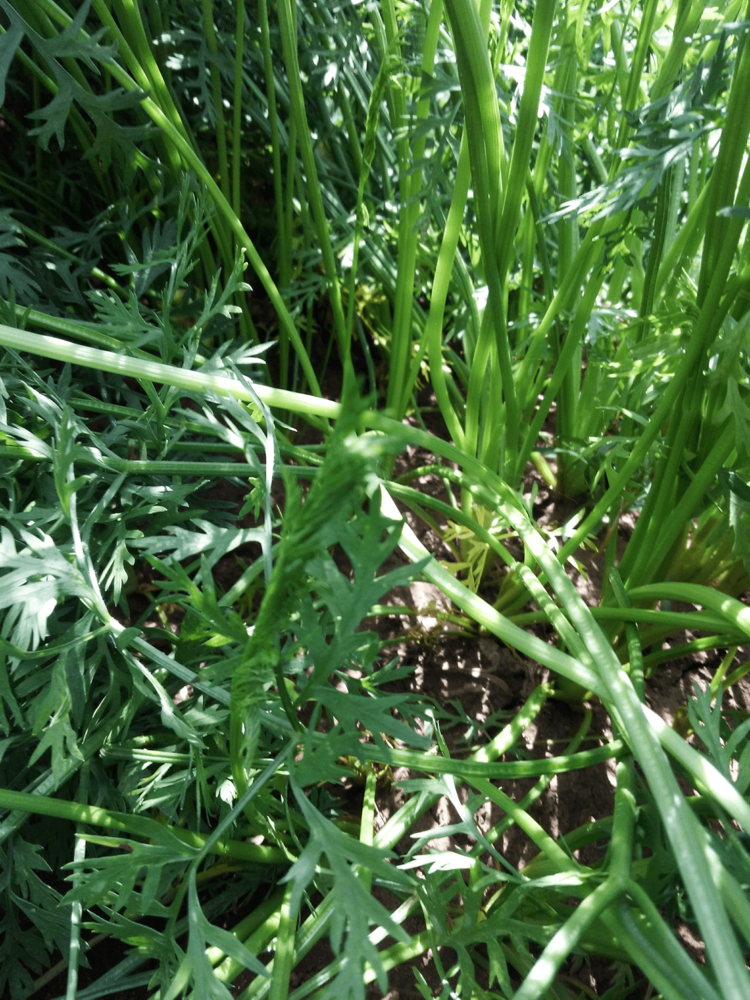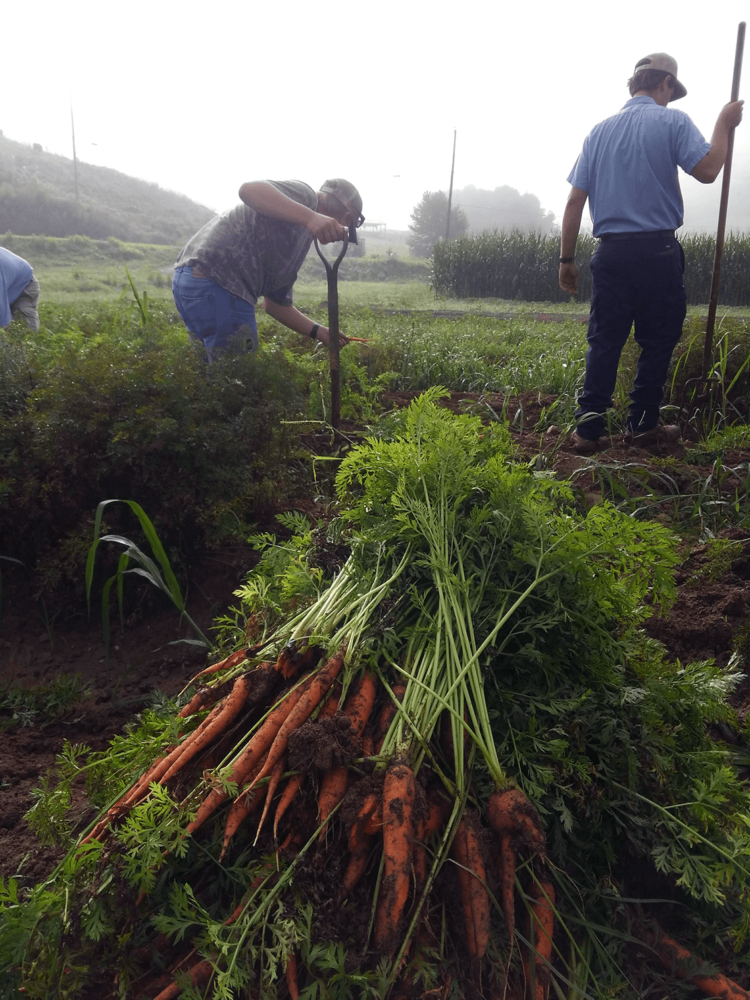by Dylan Alexander, Lomax Farm Coordinator

Have ever tried to grow carrots and had problems with germination? You are not alone.
Running the beginning farmer program at CFSA’s research and education farm, I get a lot of questions about growing vegetables, with carrots near the top of that list—specifically regarding germination.
Carrots can be frustrating with their sometimes lengthy germination time but are still one of my favorite vegetables to grow. That said, carrots can be difficult to grow because of weed and disease pressure. They’re not very competitive with weeds, especially when germination is slow and diseases are common, particularly in wet conditions (poor drainage or dense sowing).
Hopefully, I can share some tips to help you improve your carrot crop.
Soil
To start, it is always important to take a soil sample and make sure your soil isn’t lacking any nutrients and that its pH is in the proper range (6 – 6.5). Add fertilizer and lime according to your soil test recommendations. Carrots are sensitive to soils high in nitrogen, so you should not have to worry about adding any nitrogen fertilizer. The soil where you are planting should be loose and drain well; carrots won’t do well in heavy or compacted soils. That’s a challenge at Lomax Farm, where our soil is high in clay, so I usually plant into freshly-tilled beds. No matter what scale you are growing at, I recommend some kind of raised bed, which warms up faster and is less prone to waterlogging compared to flat ground.
Germination
For proper germination, carrots require consistent moisture and the correct temperature, ideally 77°F. Seeds will germinate at cooler temperatures, but lower temperatures slow the process. For this reason, starting carrot seeds in the fall always leads to better germination.
Most farmers will choose overhead or drip irrigation for growing carrots. Overhead works well for starting seeds but the downside is that it also waters the area where the carrots aren’t seeded, which means more weeds to contend with throughout the season. If you have a good handle on your weed seed bank or are growing in a small space that is easy to weed, overhead irrigation may be the right choice and save you the hassle of buying and laying drip tape. I prefer drip irrigation with 4-inch emitter spacing, as it puts the water right where I want it—on the seeds. If you get the thicker drip tape (15 mil instead of 8 mil), you can use it at least two more times, cutting down on waste.

Purple carrots from NC State University’s research program in WNC
Seeding
When planting carrots, I generally plant two or three rows into 30-inch-wide raised beds. How many rows you choose to put in each bed depends on how much you want to produce; three rows per bed maximizes space but is tight for easy weeding, whereas two rows makes weeding easier.
I use non-pelleted seeds in an Earthway seeder, using the carrot plate, and set the depth to ¾-inch. I prefer this seeder over precision seeders like the Jang because I can seed more at once to ensure a nice thick row of carrots—keeping in mind that carrot seeds have a lower germination rate than most vegetable seeds, so a thicker row will help to suppress weeds.
You can also plant by hand on a smaller scale if you do not have a seeder. To do this, make a furrow with a tool handle, sprinkle in the seeds, and lightly cover.
When planting, bear in mind that diseases such as Alternaria leaf blight can be problematic in wetter locations, so it may be necessary to thin dense rows to encourage airflow and sunlight through the canopy. Under wet conditions, there may always be a management conflict between suppressing weeds with dense plantings vs. preventing disease with thin plantings. Choosing disease-resistant varieties may be the best way to focus on weed suppression while avoiding disease. A good resource for variety selection and organic management is Cornell’s Organic Production and IPM Guide for Carrots.

Dappled light reaches the soil surface
Irrigation
Once the seeds are planted, I place my drip tape into the furrow left by the seeder. This lets me place the water on top of the seed and get good germination with minimal water use. By just watering the furrow, the carrots get the water and not the weeds. As your carrots grow, the drip tape will remain where it’s needed most. This can also be helpful during harvest. If the ground is dry and too hard to pull carrots–and you don’t want to dig–turn on the water for a little while. Moist soil will soften the soil and allow you to pull the carrots instead of digging.

Researchers harvesting in the carrot plots at NCDA’s Mountain Research Station
Variety
The variety you choose will also be important in the success of your crop. I have used Yaya for the past few years with good results. Yaya is a Nantes-type carrot that is available through several seed suppliers. While any Nantes type should perform similarly, I prefer this variety because I know it does well at Lomax and that I can seed heavily without having to worry about thinning the rows (providing good weed suppression and little disease occurrence). Carrots of this variety will grow beside each other and still size up nicely. They also have small, strong tops, which is good for harvesting and markets.
These tips have led to better production for me, I hope that they can help you improve your next crop of carrots.
Questions?
If you’re interested in learning more:
- Learn more about the Elma C. Lomax Research and Education Farm
- See our Resources for Growers section
- Peruse our library of other expert tips written by our Farm Services staff!
- Email the article author, Dylan, at dylan@carolinafarmstewards.org
All photos are courtesy of Leonora Stefanile, North Carolina State University


